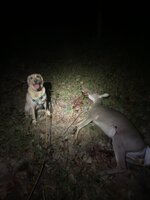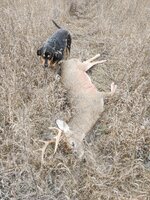Since most of the responses here are about following blood sign, i will just highlight the basic tracking skill set since knowing the basics of tracking will make you a better hunter from both a scouting and recovery standpoint. Once you learn to identify the sign/spoor of the animal that you are hunting, it is often easier to follow the sign a wounded animal left behind rather than just looking for blood spray or drops.
The best way to start tracking is to go out with an experienced tracker who will show exactly what they are looking at on the ground. Since that is not always possible, another way to start is to get a good book that will show you what to look for. There are lots of books that show what an elk or black bear track look like. But most books don't tell you how to follow the trail when there is not a big obvious track in the mud in front of you. The books below teach you how to follow a trail even if it is bent grass, flattened leaves, etc.
1. Mammal Tracks & Sign: A Guide to North American Species by Casey McFarland and Mark Elbroch
2. Practical Tracking by Adriaan Louw, Mark Elbroch, Louis Liebenberg
3. The Comprehensive Guide to Tracking: How to Track Animals and Humans by Using All the Senses and Logical Reasoning by Cleve Cheney
You have to put in a lot of time studying the ground to become an experienced tracker. You also need to become very familiar with the local vegetation and what it looks like when it is disturbed. A ranger in the Kruger National Park in South Africa told me that they once brought in expert trackers from the Kalahari in Botswana to help with tracking leopards and cheetahs on some conservation project. He said that, despite their fame, the Kalahari trackers were not as effective as the local Shangaan trackers, in part because they had never tracked in rocky terrain and the vegetation and soil substrates were different than the Kalahari.
You can learn a lot from tracking any animal and a lot of the basics are the same. Take your large dog out for a walk in the woods and then return and try to follow the tracks of your dog. It will be fairly easy since your own tracks are right next to the dog tracks, but by seeing how the grass is bent, small, flattened areas in pine needles, disturbed/discolored leaf litter, etc. will all show you the disturbances that any animal makes when walking or running through a natural environment. Then go find deer or elk tracks and try to follow the tracks, scuff marks, flattened grass, etc. until you find the next obvious track to confirm you are still on the correct trail.
For example, a whitetail in an eastern forest will leave a pattern in the leaf litter as it runs away that is often easier to see than blood drops. The same with tall grass. The trail of a deer running through leaves will look different than a black bear or a person running through leaves. But everything is going to leave a trail unless it can fly or is walking on bare rock. Obviously, some terrain is going to be a lot tougher to track in.
I consider myself to be a good tracker. I grew up hunting and tracking lost horses and cattle. Then I learned to track people, trained with the Border Patrol and local SAR teams, and tracked human adversaries post-contact in Afghanistan. But when I lived in Africa for 3 years, I was amazed by the tracking skill of some of the locals. Not every rural villager there knows how to track. Most don't. But there are some trackers (locals and white PHs) there are incredibly skilled. They are not born that way, just that the culture they grow up in places a huge amount of importance on tracking.
I did several tracking courses in the Limpopo province of South Africa, 1-2 weeks camping in a tent bush camp inside the Kruger greater area and every day you will track elephant, lion, leopard, buffalo, rhino, or hyena on foot until you get a visual on the animal. I probably learned more in those 2 weeks than I did the 10 years before.
There are tracking courses here in the U.S. although with most of them I probably would not mention anything about hunting. Also, I doubt the level of tracking skill of the instructors is going to be at the same level as the tracking courses in Africa where they have very strict standards on who can teach and certify tracking.


